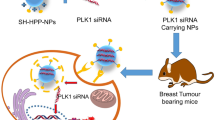Abstract
Specific and effective delivery of drugs and genes to cancer cells are the major issues in successful cancer treatment. Recently, targeted cancer gene therapy has been emerged as a main technology for the treatment of different types of cancers. Among various synthetic carriers, polyethylenimine is one of the most well-known polymers for gene delivery. In this study, we conjugated phage-derived peptide (DMPGTVLP) to polyethylenimine (10 kDa) via disulfide bonds for targeted gene delivery into breast adenocarcinoma cells (MCF-7). As negative-control cells, we used non-related hepatocellular carcinoma cells (HepG2). Peptide-conjugated polyplex exhibited low cytotoxicity and significantly increased the transfection efficiency in comparison with unmodified polyethylenimine. Therefore, the peptide-modified vector can be used as a good targeting agent for gene or drug delivery into breast adenocarcinoma cells.






Similar content being viewed by others
References
Mintzer MA, Simanek EE. Nonviral vectors for gene delivery. Chem Rev. 2008;109:259–302.
Scanlon KJ. Cancer gene therapy: challenges and opportunities. Anticancer Res. 2004;24:501–4.
Templeton NS, Lasic DD, Frederik PM, Strey HH, Roberts DD, Pavlakis GN. Improved DNA: liposome complexes for increased systemic delivery and gene expression. Nat Biotechnol. 1997;15:647–52.
DE Smedt SC, Demeester J, Hennink WE. Cationic polymer based gene delivery systems. Pharm Res. 2000;17:113–26.
Martin B, Sainlos M, Aissaoui A, Oudrhiri N, Hauchecorne M, Vigneron J-P, et al. The design of cationic lipids for gene delivery. Curr Pharm Des. 2005;11:375–94.
Simeoni F, Morris MC, Heitz F, Divita G. Insight into the mechanism of the peptide‐based gene delivery system MPG: implications for delivery of siRNA into mammalian cells. Nucleic Acids Res. 2003;31:2717–24.
Dufes C, Uchegbu IF, Schätzlein AG. Dendrimers in gene delivery. Adv Drug Deliv Rev. 2005;57:2177–202.
Li S, Huang L. Nonviral gene therapy: promises and challenges. Gene Ther. 2000;7:31–4.
Fischer D, Bieber T, LI Y, Elsasser H-P, Kissel T. A novel non-viral vector for DNA delivery based on low molecular weight, branched polyethylenimine: effect of molecular weight on transfection efficiency and cytotoxicity. Pharm Res. 1999;16:1273–9.
Parhiz H, Hashemi M, Hatefi A, Shier WT, Amel Farzad S, Ramezani M. Arginine-rich hydrophobic polyethylenimine: potent agent with simple components for nucleic acid delivery. Int J Biol Macromol. 2013;60:18–27.
Ahn C-H, Chae SY, Bae YH, Kim SW. Biodegradable poly (ethylenimine) for plasmid DNA delivery. J Control Release. 2002;80:273–82.
Sadeqzadeh E, Rahbarizadeh F, Ahmadvand D, Rasaee MJ, Parhamifar L, Moghimi SM. Combined MUC1-specific nanobody-tagged PEG-polyethylenimine polyplex targeting and transcriptional targeting of tBid transgene for directed killing of MUC1 over-expressing tumour cells. J Control Release. 2011;156:85–91.
Zhang Y, Hong H, Cai W. Tumor-targeted drug delivery with Aptamers. Curr Med Chem. 2011;18:4185–94.
Park IK, Lasiene J, Chou SH, Horner PJ, Pun SH. Neuron‐specific delivery of nucleic acids mediated by Tet1‐modified poly (ethylenimine). J Gene Med. 2007;9:691–702.
Tian H, Lin L, Chen J, Chen X, Park TG, Maruyama A. RGD targeting hyaluronic acid coating system for PEI-PBLG polycation gene carriers. J Control Release. 2011;155:47–53.
Moffatt S, Wiehle S, Cristiano RJ. Tumor-specific gene delivery mediated by a novel peptide-polyethylenimine-DNA polyplex targeting aminopeptidase N/CD13. Hum Gene Ther. 2005;16:57–67.
Qian Y, Zha Y, Feng B, Pang Z, Zhang B, Sun X, et al. PEGylated poly (2-(dimethylamino) ethyl methacrylate)/DNA polyplex micelles decorated with phage-displayed TGN peptide for brain-targeted gene delivery. Biomaterials. 2012;34:2117–29.
Pi Y, Zhang X, Shi J, Zhu J, Chen W, Zhang C, et al. Targeted delivery of non-viral vectors to cartilage in vivo using a chondrocyte-homing peptide identified by phage display. Biomaterials. 2011;32:6324–32.
Smith GP. Filamentous fusion phage: novel expression vectors that display cloned antigens on the virion surface. Science. 1985;228:1315–7.
Rasmussen UB, Schreiber V, Schultz H, Mischler F, Schughart K. Tumor cell-targeting by phage-displayed peptides. Cancer Gene Ther. 2002;9:606–12.
Molek P, Strukelj B, Bratkovic T. Peptide phage display as a tool for drug discovery: targeting membrane receptors. Molecules. 2011;16:857–87.
Bedi D, Musacchio T, Fagbohun OA, Gillespie JW, Deinnocentes P, Bird RC, et al. Delivery of siRNA into breast cancer cells via phage fusion protein-targeted liposomes. Nanomedicine: Nanotechnol Biol Med. 2011;7:315–23.
Hashemi M, Parhiz B, Hatefi A, Ramezani M. Modified polyethyleneimine with histidine–lysine short peptides as gene carrier. Cancer Gene Ther. 2010;18:12–9.
Marelli UK, Rechenmacher F, Sobahi TRA, Mas-Moruno C, Kessler H. Tumor targeting via integrin ligands. Front Oncol. 2013;3:222.
Shahidi‐Hamedani N, Shier WT, Moghadam Ariaee F, Abnous K, Ramezani M. Targeted gene delivery with noncovalent electrostatic conjugates of sgc‐8c aptamer and polyethylenimine. J Gene Med. 2013;15:261–9.
Li J, Feng L, Fan L, Zha Y, Guo L, Zhang Q, et al. Targeting the brain with PEG–PLGA nanoparticles modified with phage-displayed peptides. Biomaterials. 2011;32:4943–50.
Carlisle RC, Bettinger T, Ogris M, Hale S, Mautner V, Seymour LW. Adenovirus hexon protein enhances nuclear delivery and increases transgene expression of polyethylenimine/plasmid DNA vectors. Mol Ther. 2001;4:473–83.
Nam HY, Nam K, Hahn HJ, Kim BH, Lim HJ, Kim HJ, et al. Biodegradable PAMAM ester for enhanced transfection efficiency with low cytotoxicity. Biomaterials. 2009;30:665–73.
Niidome T, Urakawa M, Takaji K, Matsuo Y, Ohmori N, Wada A, et al. Influence of lipophilic groups in cationic alpha-helical peptides on their abilities to bind with DNA and deliver genes into cells. J Pept Res. 1999;54:361–7.
Acknowledgments
This work was funded by Mashhad University of Medical Sciences, Mashhad, Iran. Additional financial support provided by the Iranian Nanotechnology Initiative is gratefully acknowledged. The results presented here were part of A. Mokhtarzadeh PhD thesis.
Author information
Authors and Affiliations
Corresponding authors
Electronic Supplementary Material
Below is the link to the electronic supplementary material.
Supplementary Figure 1
Characterization of the peptide conjugates by RP-HPLC. (1) Positive peptide (PP), (2) DTT, (3) PEI-PP, (4) DTT treated PEI-PP (JPEG 45 kb)
Supplementary Figure 2
FTIR analysis of PEI 10 and PEI 10-PP vectors (JPEG 46 kb)
Supplementary Figure 3
Transfection efficiency of polyplexes prepared from plasmid DNA encoding the green fluorescent protein (GFP) and PEI 10 kDa or the peptide-conjugated PEI 10 (JPEG 18 kb)
Rights and permissions
About this article
Cite this article
Mokhtarzadeh, A., Parhiz, H., Hashemi, M. et al. Targeted Gene Delivery to MCF-7 Cells Using Peptide-Conjugated Polyethylenimine. AAPS PharmSciTech 16, 1025–1032 (2015). https://doi.org/10.1208/s12249-014-0208-6
Received:
Accepted:
Published:
Issue Date:
DOI: https://doi.org/10.1208/s12249-014-0208-6




